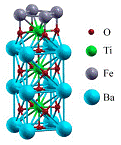Department of Physics and Astronomy: Publications and Other Research

Evgeny Tsymbal Publications
ORCID IDs
Tsymbal http://orcid.org/0000-0002-6728-5556
Document Type
Article
Date of this Version
7-28-2017
Citation
Physical Review B (2017) 96: 014435
doi: 10.1103/PhysRevB.96.014435
Abstract
Voltage-controlled magnetic anisotropy (VCMA) is an efficient way to manipulate the magnetization states in nanomagnets and is promising for low-power spintronic applications. The underlying physical mechanism for VCMA is known to involve a change in the d orbital occupation on the transition-metal interface atoms with an applied electric field. However, a simple qualitative picture of how this occupation controls the magnetocrystalline anisotropy (MCA) and even why in certain cases the MCA has the opposite sign remains elusive. In this paper, we exploit a simple model of orbital populations to elucidate a number of features typical for the interface MCA, and the effect of the electric field on it, for 3d transition-metal thin films used in magnetic tunnel junctions. We find that in all considered cases, including the Fe(001) surface, clean Fe1−xCox (001)/MgO interface, and oxidized Fe(001)/MgO interface, the effects of alloying and the electric field enhance the MCA energy with electron depletion, which is largely explained by the occupancy of the minority-spin dxz,yz orbitals. However, the hole-doped Fe(001) exhibits an inverse VCMA in which the MCA enhancement is achieved when electrons are accumulated at the Fe (001)/MgO interface with the applied electric field. In this regime, we predict a significantly enhanced VCMA that exceeds 1 pJ/Vm. Realizing this regime experimentally may be favorable for the practical purpose of voltage-driven magnetization reversal.


Comments
Copyright 2017, American Physical Society. Used by permission